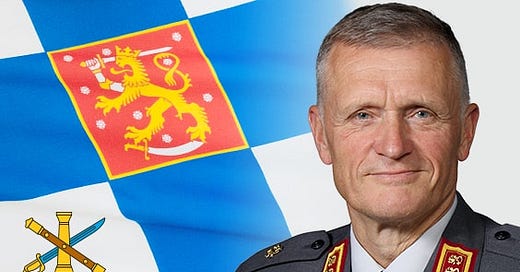Finland's Chief of Defense: 2% of GDP is not enough.
General Kivinen calls on Europe to spend more and do more to defend itself.
Meet General Timo Kivinen.
Kivinen is the 64-year-old tough-as-nails Finnish Chief of Defense (CHOD), a position he has held since August of 2019. Kivinen began his military career as a conscript in 1977 and will retire later this year.
I first met General Kivinen in the summer of 2017 when he was the Deputy Chief of Strategy at Defense Command (think CJCS Deputy J5). Later that year he became Chief of Defense Command (roughly equivalent in responsibility to the Chairman of the Joint Chiefs of Staff) before becoming Finland’s highest ranking military officer- the Chief of Defense.1
Earlier in his career as an infantry officer, Gen Kivinen attended the U.S. Army Airborne and Ranger Courses, led SFOR troops in Bosnia and Herzegovina, Commanded the Utti Jaeger Regiment (home of all of Finland’s Special Operations Forces), attended numerous courses in the USA, UK, and other NATO nations, and Commanded Finland’s Karelia Brigade, which just happens to abut the Russian border. He is no armchair General.
Known for his fitness, I’ve been told that he competes in the Finnish sport of orienteering, which involves running through the forest at full speed in the dark of night to find the next waypoint. A far cry from the orienteering I used to do at Scout Camp. Just last week, he celebrated Hungary’s approval of Sweden’s NATO accession by completing a 90km cross-country ski race in Sweden along with his Swedish and Norwegian counterparts.

I once ran into Gen Kivinen in downtown Helsinki during lunch time. He was returning to his office after having bought some ammunition for his regular weekend hunting trip. I believe he was going bear hunting, but I could be wrong.
You get the idea. He is a soldier’s soldier.
General Kivinen’s Speech at the start of the 248th National Defense Course
Yesterday (March 3) Kivinen gave an introductory speech to the National Defense Course (maanpuolustuskurssin) for the last time before his retirement. This highly selective and prestigious quarterly course has attendees from multiple sectors of Finnish society who have some position or task directly related to national defense, which in Finland is a constitutional responsibility of every citizen. Attendees at any given course may include Members of Parliament, politicians, business leaders, media representatives, members of the Finnish Defense Forces, police, emergency response organizations, and leaders from other important sectors.
Here are some excerpts from his speech (original in Finnish here) translated by me, assisted by google. The headlines- and comments below the quote box- are mine.
Two percent is not enough.
Regardless of how and when the war in Ukraine ends and who is the next president of the United States, it is clear that Europe must do more for its own security. From a military point of view, it simply means two things, increasing defense budgets and increasing the capacity and capability of the European defense industry. Investments in the defense industry are also a prerequisite for long-term support of Ukraine. It seems to me that the defense spending level of two percent of GDP2 agreed by the NATO countries together will not be enough to cover everything that Europe has to do.
More money is not enough.
The challenges related to the defense industry cannot be solved with money alone, but also requires intervention in regulation. We live in extraordinary times. The security concepts of the West and Russia seem to be in irreconcilable conflict. In such times, extraordinary measures are needed. Since raising the production capacity takes time and Ukraine's need for support is immediate, and our own emergency stocks cannot be filled in an instant, concrete measures are needed now.
As he said earlier, Europe needs to increase the capacity and capability of its defense industries. Europe’s inability to provide the pledged one million rounds of 155mm artillery ammunition to Ukraine by this month (about half were delivered) should be a wake-up call for other areas of defense production.
The EU and NATO are complementary, should not be in competition. But the EU needs to start moving.
The European Union's military cooperation focuses on crisis management outside its own territory and the development of military capabilities, while NATO is responsible for collective deterrence and defense. We should all be investing in the capacity and capability of the European defense industry. The EU countries' defense investments thus produce military capabilities primarily for national use, but this also strengthens European defense as part of NATO. The European Union also plays a role in promoting military mobility. It is about the EU's Military Mobility project, which is used to improve the mobility of troops and equipment in the European region. The EU could speed this up by issuing a directive that would direct the member states to harmonize their regulations related to military mobility.
Here General Kivinen clearly states the Finnish position on the EU and NATO. The EU, and its military initiative (such as the Permanent Structured Defense Cooperation, known as PESCO), have a place- to develop the European industrial base, prevent unnecessary duplication, and align each nation’s laws to allow enhanced cooperation. The EU should continue to lead crisis management operations (also known as peacekeeping operations) outside of Europe. However, NATO should and must be the only vehicle for deterrence and defense of Europe. European Stategic Autonomy, an idea that keeps popping up in some European circles, is a dangerous distraction. Kivinen’s mention of the Military Mobility Project might be a soft criticism, as this PESCO project dates back to 2017 but has achieved little. The idea is sound, as the project is meant to,”simplify and standardize cross-border military transport procedures. It aims to enable the unhindered movement of military personnel and assets within the borders of the EU. This entails avoiding long bureaucratic procedures to move through or over EU member states, be it via rail, road, air or sea.” However, after seven years, not much has changed.
It’s nice to see the rest of Europe joining us.
Recently, many of my colleagues, the commanders of the armed forces of European countries, have indeed used weighty speeches to speed up their own countries' preparedness measures. In Finland, there hasn't been a similar need for this, because we didn't operate the way most of us did after the Cold War, but we have maintained overall security and overall national defense arrangements.
Finland maintains 100% male conscription, has one of the largest and best-trained reserve forces in Europe despite its small population, and has internalized national defense in a way that you have to see to believe. A previous boss told me that people used to refer to Finland as “an open-air Cold War Museum. The Finns didn’t mind. They knew they were just being smart.
Concluding thought:
General Kivinen obviously isn’t the only one who thinks that Europe needs to do more for its own defense. This opinion is widely shared within Europe in a way that I don’t often see reported in the U.S. or English language press, so I thought I would share this for the benefit of the Americans in my growing audience. To my Finnish readers- you know.
Thanks for reading, subscribing, and spreading the word.
PGR
Some might say that the CHOD is equivalent to the CJCS, as both are the top uniformed positions in the Finnish and U.S. Militaries. However, unlike the CJCS the CHOD has operational responsibility- he commands all the troops during wartime, reporting directly to the Commander in Chief (President of Finland). Unlike the U.S. Secretary of Defense, the Finnish Minister of Defense has no operational responsibilities at all.
Finland currently spends about 2.3% of GDP on defense, but this likely understates its commitment. In 2014, building off a 2006 pledge, all NATO nations committed to spending 2% of GDP on defense, with 20% of defense spending going to procurement. In 2023 only 11 of 31 NATO nations met the 2% goal.




